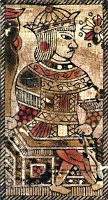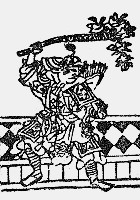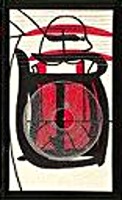Japanese playing cards of western origin
In the middle of the 16th century, Portuguese sailors brought western playing cards to southern Japan; and before the end of the century, copies were produced locally. Bans targeting gambling and distrust of foreign cultural influences later made it necessary to create variant forms with more indigenous features.
Terms
The primary word for cards is karuta, from
Portuguese carta. Because of the age of this loanword,
it can be written in a bewildering number of ways. About equally
frequent are かるた in hiragana as other old
loans that have been naturalised and カルタ in
katakana, like modern loanwords. Archaic and more rarely seen are
sound-ateji forms
like 歌留多, 加留多 or 嘉留太 using kanji for their sound value without
reference to their meanings.
The kanji 骨牌 might be read karuta, but primarily represents koppai
こっぱい, meaning a particular type of cards, or
bone mahjong tiles
(from Chinese gǔ pái meaning
bone tile
, referring to dominoes).
Besides this, the term fuda ふだ might
be used for at least some forms of playing cards. This may also be
written with the kanji 札 with the primary
meaning paper money
, and in this sense read satsu
さつ.
Portuguese cards
It is perhaps not too surprising that the cards brought by Portuguese sailors were of the style called Portuguese. However, this style was also prevalent in southern Spain (where it presumably originated), in southern Italy and on Malta. At the same time it reached Japan, it also spread to South America – alongside the so-called Spanish style originating in northern Spain – and to the Netherlands. It never took root in the Netherlands, and in South America, southern Spain and southern Italy it was eventually supplanted by the Spanish style. For a long time it stayed the national pattern of Portugal, but was in the end replaced by the French style there.
Like Spanish cards and Italian cards from northern Italy, Portuguese cards are composed of the suits of swords, clubs, cups and coins. Each suit has three court cards; king, knight and knave. The aces tend to be fairly elaborate, often with the suit symbol in a different style from the pip cards.
The Portuguese style is primarily characterised by having long
straight interlaced swords in the pip cards, in difference to the
Italian style (and most Tarot patterns, which are based on this)
with long curved interlaced swords and the Spanish style with
short straight non-overlapping swords. Since the Italian style
corresponds closely to the only known pack from the islamic world (which
though it is later than the earliest European specimens is generally
regarded as representing the prototype from which these sprang), it is
probably the earliest in this regard; while the Portuguese is
intermediate between this and the Spanish. This impression is
strengthened by a similar relation between the forms of the clubs:
interlaced, long, of even thickness and smooth in the Italian
style; interlaced, long, tapering and somewhat knobbly
in the
Portuguese; and separate, short, tapering and very knobbly
in the Spanish.
Features shared between Portuguese and contemporary
Spanish style cards are the reduction from 52 to 48 cards through
removal of the tens, and the name sota for the lowest
court card, meaning knave
or servant
(without regard to
gender), literally lower [rank]
– as opposed to Italian fante, meaning infantry soldier
.
Features unique to the Portuguese style, besides the treatment of swords and clubs described above, are that the sotas are female, and that the suit symbols in the aces are held by dragons.
Tenshō karuta 天正かるた
 The earliest cards are now distinguished from later types by the term Tenshō karuta 天正かるた, after the Tenshō period (1573–1592), although they were also made
before and after that. These cards retain all the features particular to
Portuguese style cards described above.
The earliest cards are now distinguished from later types by the term Tenshō karuta 天正かるた, after the Tenshō period (1573–1592), although they were also made
before and after that. These cards retain all the features particular to
Portuguese style cards described above.
Though long since extinct in the original form, ample evidence for most aspects of Tenshō karuta survive. A single card from around 1600 survives, and so does the complete set of woodblocks for printing the pack it belongs to – reworked into a box. A peculiar feature of this particular pack is that it corresponds to Portuguese cards that have their edges trimmed away, so that parts of the illustrations are removed and the size is noticeably smaller. Oddly enough this creates a strong but accidental similarity to Chinese money-suited packs – probably close to the ultimate ancestor of all western cards – where due to the narrow format, many of the coins in the cash suit are only partially shown.
When later types of Japanese cards preserves features in common with the European original, these must be assumed to also have been present in the Tenshō karuta. Among these are the Portuguese-derived names of the suits and court cards:
- pau ぱう – from paus
clubs
- isu いす – from espadas
swords
(shortened) - koppu こっぷ – from copas
cups
- ōru おうる – from ouros
coins
(literally the plural ofgold
) - rei れい – from rei
king
- kaba かば – from cavaleiro
knight
or cavalohorse
(shortened) - sōta そうた – from sota
servant
literallylower [rank]
Later some of the Portuguese-derived names are replaced by indigenous ones:
- pau becomes hau はう,
flower
, and the clubs are shown sprouting flowers. - kaba becomes uma うま
horse
.
In the suits of koppu and ōru, the pip cards rank in reverse, with the ace being the highest card and 9 the lowest. This feature is not only shared with their European predecessors, but at least for coins goes all the way back to the earliest Chinese playing cards.
Unsun karuta うんすんかるた
 In the second half of the 17th century, an expanded 75-card pack with
some indigenous features appeared. A fifth suit is added, and each suit
is expanded from twelve to fifteen cards.
In the second half of the 17th century, an expanded 75-card pack with
some indigenous features appeared. A fifth suit is added, and each suit
is expanded from twelve to fifteen cards.
- The rei is reinterpreted as an infantry soldier, and renamed kiri きり.
- The
dragon ace
is split into two cards, a normalone
, and a robai ろばい normally ranking right above that, keeping the dragon design. In the trump suit it is promoted to above kiri, and if hau is not trump, the robai of this suit becomes an extra trump above the robai of the trump suit itself. - The sōta is reinterpreted as a queen, and in the trump suit promoted to above the robai (also above the robai of hau).
- Two new court cards, un うん and sun すん, are added above the other court cards.
The fifth suit is called guru ぐる,
related to guruguru ぐるぐる turning
round and round
. Its suit sign is the mitsudomoe
三つ巴 symbol, which looks like a wheel with three
comma-like spokes. Like coins and cups, the pip cards of this suit is
ranked in reverse.
While early Tenshō karuta faithfully copied their European prototypes; later ones gave the persons on the court cards a more Japanese look. The novations in Unsun karuta amplify this trend:
- The un cards feature Japanese mythological figures.
- The sun cards feature Chinese persons.
- The traditional Japanese mitsudomoe symbol is used for the fifth suit.
Sunkun karuta すんくんかるた
 Around 1700, a further expanded variant of the Unsun
karuta appeared. With a sixth suit and a sixth court card, as well
as a second copy of the robai of hau
(with a more old-fashioned design), the result is a 97-card pack. The
reason for duplicating the latter card is undoubtedly related to the
role of this card as a permanent trump in the normal 75-card Unsun karuta, a feature itself borrowed from European
games of the Hombre family.
Around 1700, a further expanded variant of the Unsun
karuta appeared. With a sixth suit and a sixth court card, as well
as a second copy of the robai of hau
(with a more old-fashioned design), the result is a 97-card pack. The
reason for duplicating the latter card is undoubtedly related to the
role of this card as a permanent trump in the normal 75-card Unsun karuta, a feature itself borrowed from European
games of the Hombre family.
The sixth suit has an arrow as its suit symbol. In a museum
presentation, the Japanese term ya 矢
meaning arrow
is used to refer to it, but it is unclear whether
this would also have been its contemporary designation. In the pip
cards, the arrows are interlaced like clubs and swords, and are ranked
normally like these.
The additional court card kun くん is
the highest ranking one. It shows a wise man
seated on a throne,
somewhat reminiscent of the rei of Tenshō
karuta.
Mekuri karuta めくりかるた
 In the early 18th century, a graphical variation of the Tenshō karuta was introduced in order to circumvent bans
on playing cards. Apart from the addition of a joker-like extra card
outside the normal suits and ranks, it is structurally identical to Tenshō karuta and Portuguese cards.
In the early 18th century, a graphical variation of the Tenshō karuta was introduced in order to circumvent bans
on playing cards. Apart from the addition of a joker-like extra card
outside the normal suits and ranks, it is structurally identical to Tenshō karuta and Portuguese cards.
The cards have the same names and functions as late Tenshō karuta except for rei being
modified to koshi こし prince
. The
additional card is called kinfuda 金札.
Several regional varieties developed, varying mainly in graphical design. In general, the pip cards were simplified and the court cards obfuscated; both printed in black and red on white background, sometimes with silver details on top.
Kabu karuta 株かるた
 Later in the 18th century, a simplified form of Mekuri
karuta appeared. Each of the several different patterns that
developed consists of four copies of a single suit from a Mekuri pack; either ōru or hau.
Later in the 18th century, a simplified form of Mekuri
karuta appeared. Each of the several different patterns that
developed consists of four copies of a single suit from a Mekuri pack; either ōru or hau.
In the hau patterns, the ace and four of one of the sets are marked as special; otherwise all sets are identical. This marking is partially in the form of silver overlays and partially by a more fundamentally different design. In the ōru patterns, there is also a special three, and in a single pattern all twelve cards of one set are special.
The other ōru patterns are also reduced to ten cards per suit by dropping the two highest court cards, leaving only the sōta. The same is the case for a single hau pattern, where the design of the sōta is not based on Mekuri cards, but rather on a standard western Jack. This is also the only Kabu pattern without a kinfuda card.
Tehonbiki 手本引き
This game uses two different packs, each consisting of a single suit of cards from one to six, repeated several times. One of the packs employs ace to six of ōru from a Mekuri or Kabu pack – this is the extent of the relationship to other cards games. The other pack is not based on any other type of cards, but consists of stylised versions of the Chinese numerals from one to six.
By coincidence, this resembles the relationship between coins
and myriads
in the Chinese money-suited cards, where the former
represented the value by repeating the image of a coin, while the latter
expressed this by Chinese numerals.
Hanafuda 花札
Here too, the relationship to other types of cards is somewhat
tenous. Structurally, a Hanafuda pack consists of
twelve suits
of four cards each, rather than the other way round
as in Tenshō, Mekuri and Kabu karuta.
In each suit, two cards are normal
and two are special cards
(one suit also has a third). There are three types of special cards, and
no suit contains more than one of each type.